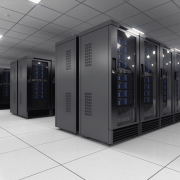7 Infrastructure Questions for Prospective ERP Vendors
When searching for a new ERP solution, almost everyone understands the importance of thorough due diligence on a prospective system’s features and applicability for business requirements.
But another important area of focus is often left by the wayside: infrastructure. Without the proper IT resources, even the most feature-rich ERP system can leave your employees frustrated by long-running reports, stranded offsite team members, slow functionality, or clunky VPN connections. A bad decision can even shut down your company for days at a time due to hardware failures or power outages.
To avoid costly mistakes, be sure to ask these questions to any prospective ERP vendor, and ensure their answers are vetted by your IT department, so everyone involved understands these critical considerations.
Is your product on-premise or cloud hosted?
ERP systems can generally be divided into two categories: “on-premise” products, which are installed on hardware housed in your facilities, and “cloud” products like Bizowie Cloud ERP, which are installed in a data center.
On-premise products generally require the purchase and installation of servers, which will be housed in your facility. They will also require that you have sufficient IT resources (internal or third-party) to maintain this equipment, keep it up to date, and ensure that it is secure.
By contrast, cloud products are installed on servers housed in a third-party data center. Generally, cloud-hosted options will not require that you purchase hardware, though there are often hosting costs that are separate from your software licensing costs.
Whether your vendor offers an on-premise solution, cloud hosted solution, or both, it’s important to ensure that you determine the full TCO (total cost of ownership) for each option, taking into account not just your spend with the software vendor, but also any third-party costs such as the software license, IT resources to maintain the servers, backups, etc.
If it’s cloud hosted, is it multi-tenant or single-tenant?
Cloud hosted systems can be divided into two categories: single-tenant and multi-tenant.
Single-tenant solutions are on-premise products installed in a third-party data center, instead of on hardware at your facility. You’ll have your own servers (whether they’re virtual), and you will be limited by the amount of computing power you pay for.
Multi-tenant solutions are products where computing resources and servers are “pooled”, so resources are shared by many different users. Multi-tenant solutions generally allow for more flexibility in growth, since users are not limited by servers specific to their use case.
These days, nearly every modern business system – including Bizowie Cloud ERP – is built as a multi-tenant solution. Products like Microsoft 365, Google Calendar, and Gmail are all great examples of multi-tenant software products.
Who is responsible for maintaining infrastructure, applying security patches, and coordinating backups?
An important consideration that is often ignored is ongoing maintenance of the infrastructure you’ll be using. Whether you’re considering a cloud-based or on-premise product, someone will need to be responsible for installing system updates and security patches, coordinating and verifying offsite backups, and performing other day-to-day maintenance tasks.
These ongoing maintenance tasks are absolutely critical, especially from a cybersecurity standpoint. Your ERP system houses your company’s sensitive financial data, customer lists, product specifications, and other confidential information… having an outside IT firm come in every month or two to install updates and make sure backups are happening just isn’t sufficient.
Ensure that any solution you choose includes a gameplan to ensure that expert engineers are monitoring and maintaining your infrastructure – preferably 24/7/365 – to ensure that you are always up-to-date.
What happens if my company grows? Will I need to invest in additional hardware or infrastructure, and when?
If significant growth is on your roadmap during the expected lifecycle of the software you select, it’s important to consider the impact that growth will have on your total cost of ownership.
For many systems, the impact may be as simple as additional software licenses required for newly hired team members. But in some cases – particularly with on-premise or single-tenant cloud solutions – significant growth may require the purchase of new servers and costly changes and migrations as your company grows.
When purchasing software you’ll be using for at least 5-10 years, ensure your company’s expected growth is part of the gameplan.
How does offsite or mobile connectivity work? Is a VPN or other installed software required?
The days of ERP systems that are only accessible from a single office or facility are long gone. These days, offsite access is an absolute necessity, for everyday use cases like:
- Multiple facilities or distribution centers that need to communicate in real-time
- Employees working from home
- Salespeople or field technicians working from the road
- Vendors or contractors (like outside sales reps or accounting firms) working from their own facilities
Ensure that any system you select has a mechanism for outside connectivity, and that users connecting from outside your facility won’t experience slow processing times or delayed connections when they’re working remotely.
What happens if a server goes down? Does the proposed solution include instant fail-over?
Another critical consideration is disaster recovery and failover. It’s not uncommon for businesses to purchase a “single server” ERP solution, only to discover the limitations of their infrastructure when their business is shut down for days due to failed hardware, server crash, or a power outage at the data center.
With hosting costs lower than they’ve ever been, it is simply unacceptable to deploy an ERP solution that does not have the capability to immediately and seamlessly “fail over” to alternative equipment in separate data center locations if there is any kind of a problem or outage.
If your vendor’s proposed solution does not have these capabilities, you should run away as quickly as you can. You don’t need to look much farther than your own laptop computer or cell phone to realize that computers occasionally have problems, and when that happens your company’s critical ERP infrastructure should not leave you in the lurch.
Can I see a demo in the environment where I’ll actually be hosted?
The infrastructure you utilize has a direct impact on the performance of your ERP system, which is why it’s important to see software demonstrations in the same infrastructural environment that you will actually be using.
To speed up demos, it’s not uncommon for software vendors to show off their products using software installed directly on the salesperson’s computer, making it appear far faster than it would in a normal client/server environment.
At Bizowie, we want prospective customers to see the software as they will in the “real world” – that’s why we always demonstrate our software using our actual production infrastructure, with no modifications or changes.
Ensure that any ERP vendor you review is able to demo their software to you with the same server configuration and infrastructure that they are proposing for your business.

